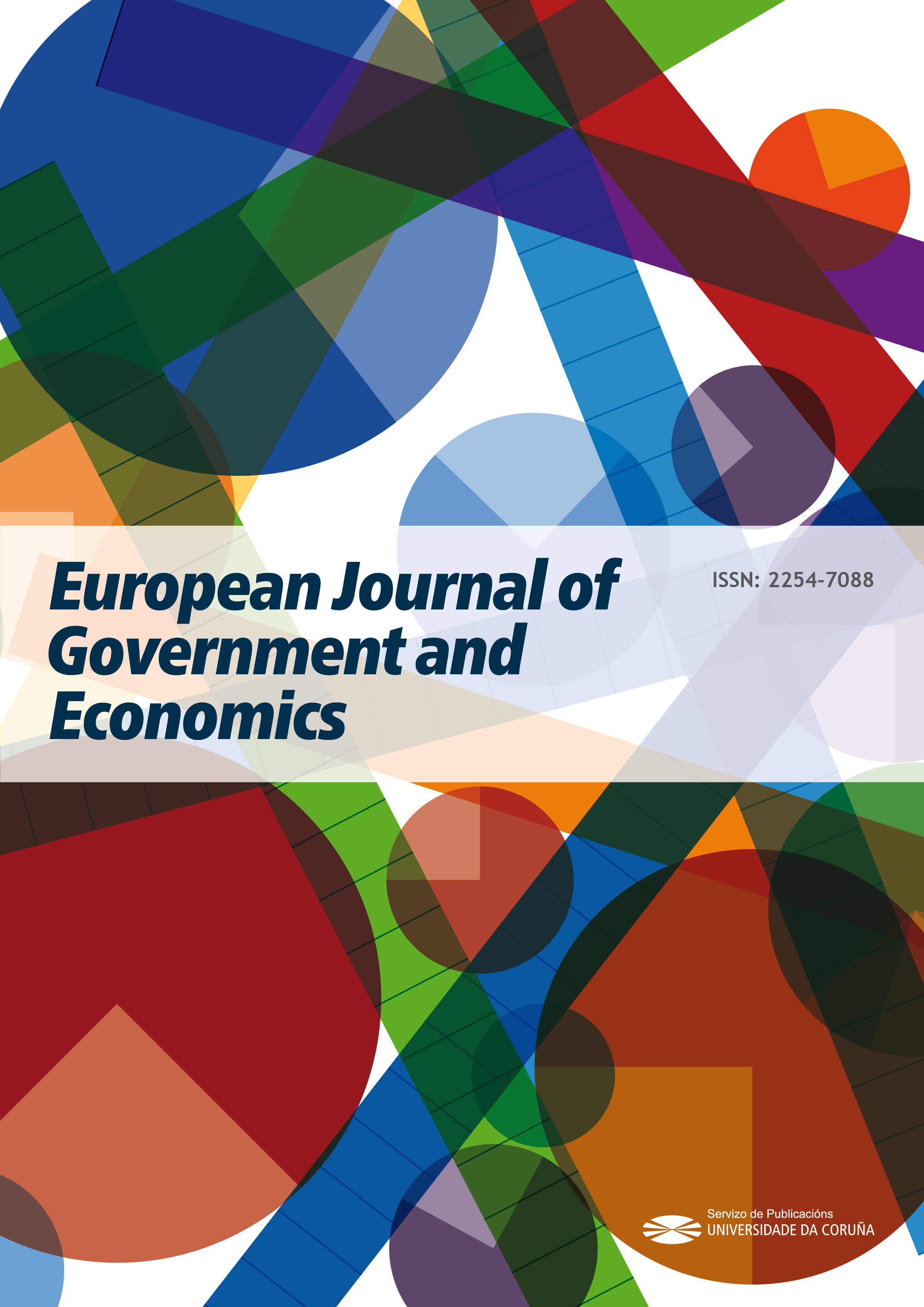Why regions fail (or succeed). The Role of Government Institutions in the Long-Run
Main Article Content
Abstract
This paper represents an attempt to reconcile some general intuitions provided by Daron Acemoglu and James A. Robinson in the book “Why Nations Fail” with the case of the deep regional disparities in the economic performances observed within the “Western” European Union during the period 2001-2015. By adopting an approach to growth analysis based on binary response models, this paper quantifies the extent to which the quality of government institutions has shaped regional economic performances in the European Union throughout the period comprising the Great Recession. Empirical results show that: 1) The higher is the quality of institutions, the higher is the probability that a region with high income per capita will grow above the levels of the European Union as a whole. 2) The higher is the quality of institutions, the lower is the probability that a low-income region will grow below the levels of European Union as a whole. 3) The higher is the quality of institutions, the higher (lower) is the probability that any region, regardless of its income per capita, will outperform (underperform) the European Union as a whole. 4) The higher is the quality of Institutions, the lower is the probability that a region will “fail” to grow.
Keywords:
Downloads
Article Details
References
Acemoglu, D. & Robinson, J. A. (2012). Why Nations Fail. The Origins of Power, Prosperity, and Poverty. New York: Crown Business. Doi: https://doi.org/10.1355/ae29-2j
Acemoglu, D. & Robinson, J. (2008). The Role of Institutions in Growth and Development. The International Bank for Reconstruction and Development / The World Bank On behalf of the Commission on Growth and Development. Working Paper No.10
Acemoglu, D., Johnson, S. & Robinson, J. A. (2005). Institutions as Fundamental Cause of Economic Growth. In Aghion, P. and Durlauf, S. (eds.) Handbook of Economic Growth 1A. Amsterdam: Elsevier B.V. Doi: https://doi.org/10.1016/S1574-0684(05)01006-3
Acemoglu D., Johnson, S. & Robinson, J. A. (2005a). The Rise of Europe: Atlantic Trade, Institutional Change, and Economic Growth. NBER Working Paper No. 9378. Doi: https://doi.org/10.1257/0002828054201305
Aiginger, K.; Firgo, M. & Huber, P. (2013). What can the EMU’s Peripheral Countries Learn from Regional Growth? In Lacina, L., Rosmahel, P. & Rusek, A. (eds.) Political Economy of the Eurozone crisis. Reforms and their Limits. Mendel European Centre
Alonso, J. A. (2009). Colonisation, formal and informal institutions, and development. ICEI Working Paper No.13
Ascani, A; Crescenzi, R. & Iammarino, S. (2012). Regional Economic Development: A Review. Search Working Paper 1/03
Barro, R. J. (1996). Determinants of Economic Growth. A Cross-country Empirical Study. National Bureau of Economic Research, Working Paper N. 5698. Doi: https://doi.org/10.3386/w5698
Barro, R. J. (1991). Economic Growth in a Cross-section of Countries. Quarterly Journal of Economics, 106 (2), 407-443. Doi: https://doi.org/10.2307/2937943
Canton, E. & Solera, I. (2016). Greenfield Foreign Direct Investment and Structural Reforms in Europe: What Factors Determine Investments? European Commission, European Economy Discussion Paper No. 033
Charron, N., Dijkstra, L. & Lapuente, V. (2015). Mapping the Regional Divide in Europe: A Measure for Assessing Quality of Government in 206 European Regions. Social Indicators Research, 122 (2), 315-346. Doi: https://doi.org/10.1007/s11205-014-0702-y
Charron, N., Dijkstra, L. & Lapuente, V. (2012). Regional Governance Matters. A study on Regional Variation in Quality of Government in the EU. European Commission Working Paper No. 01/2012
Feldkircher, M. (2006). New Regional Economics in Central European Economies: the Future of Centrope. Oesterreichische Nationalbank Working Paper No.9
Greif, A. (1994). Cultural beliefs and the Organization of Society. Theoretical reflection on Collectivist and Individualist Societies. The Journal of Political Economy, 102 (5), 912-950. Doi: https://doi.org/10.1086/261959
Harris, R. (2008). Models of Regional Growth: Past, Present and Future. SERC Discussion Papers, SERCDP0002. Spatial Economics Research Centre (SERC), London School of Economics and Political Science.
Huggins, R, & Thompson, P. (2017). Introducing Regional Competitiveness and Development: Theories and Perspectives. In Huggins, R. & Thompson, P. (eds.) Handbook of Regions and Competitiveness: Contemporary Theories and Perspectives on Economic Development. Chaltam: Edward Elgar Publishing Limited. Doi: https://doi.org/10.4337/9781783475018.00005
Lee-Jones, K. (2018). Best practices in addressing police-related corruption. Transparency International
Lucas, J. R, (1988). On the Mechanics of Economic Development. Journal of Monetary Economics, 22, 3-42. Doi: https://doi.org/10.1016/0304-3932(88)90168-7
MacMullen, R. (1988). Corruption and the Decline of Rome. New Heaven: Yale University Press
Mankiw, G.; Romer, D. & Weil, D. (1992). A Contribution to the Empirics of Economic Growth. The Quarterly Journal of Economics, 107 (5), 407-437. Doi: https://doi.org/10.2307/2118477
Martin, R. & Sunley, P. (1998). Slow Convergence? The New Endogenous Growth Theory and Regional Development. Economic Geography, 74(3), 201-227. Doi: https://doi.org/10.2307/144374
Mauro, P. (2002). The Persistence of corruption and Slow Economic Growth. The International Monetary Fund. IMF Working Paper No.02/13. Doi: https://doi.org/10.5089/9781451874952.001
Mauro, P. (1995). Corruption and Growth. The Quarterly Journal of Economics, 110 (3), 681-712. Doi: https://doi.org/10.2307/2946696
North, D.C. (1991). Institutions. Journal of Economic Perspectives, 5(1), 971-112. Doi: https://doi.org/10.1257/jep.5.1.97
Pons-Novell, J. & Viladecans-Marsal, E. (1998). Kaldor’s Law and Spatial Dependence: Evidence for the European Regions. Regional Studies, 33(5), 443-451. Doi: https://doi.org/10.1080/00343409950081284
Rodríguez-Pose, A., & Di Cataldo, M. (2014). Quality of government and innovative performance in the regions of Europe. Journal of Economic Geography, 15(4), 673-706. Doi: https://doi.org/10.1093/jeg/lbu023
Rodrik, D.; Subramianan, A. & Trebbi F. (2002). Institutions Rule: the Primacy of Institutions over Geography and Integration in Economic Development. NBER Working Paper No. 9305. Doi: https://doi.org/10.3386/w9305
Romer, P. M. (1986). Increasing Returns and Long Run Growth. Journal of Political Economy, 94, 1002–37. Doi: https://doi.org/10.1086/261420
Rothstein, B. & Uslaner, E. M. (2005). All for All: Equality and Social Trust. LSE Health and Social Care Discussion Paper No. 15. Doi: https://doi.org/10.2139/ssrn.824506






